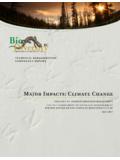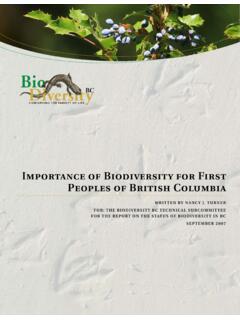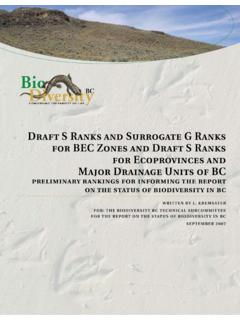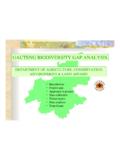Transcription of Key Elements of Biodiversity in British Columbia
1 Technical subcommitteecomponent reportKey Elements of Biodiversityin British Columbia :Some Examples from the Terrestrialand Freshwater Aquatic RealmPREPARED BY: RACHEL HOLT, VERIDIAN ECOLOGICAL CONSULTING TODD HATFIELD, SOLANDER ECOLOGICAL RESEARCH : THE Biodiversity BC TECHNICAL SUBCOMMITTEEFOR THE REPORT ON THE STATUS OF Biodiversity IN BCMAY 2007 KEY Elements OF Biodiversity IN British Columbia : SOME EXAMPLES FROM THE TERRESTRIAL AND FRESHWATER AQUATIC REALM Prepared for Conservation Planning Tools Committee1 May, 2007 Rachel F. Holt2, , Veridian Ecological Consulting Ltd. & Todd Hatfield3, , Solander Ecological Research Ltd. Acknowledgements The following people provided helpful input into this project: Rob Cannings (RBCM), Elizabeth Elle (SFU), Martin Carver (MoE), Ted Down (MoE), Deb Mackillop (MoF), Bruce Marcot (USFS), Steve McAdam (MoE), Diane Scrivastava (UBC), Jordan Rosenfeld (MoE) and Greg Utzig (Kutenai Nature Investigations Ltd).
2 Tory Stevens (MoE) provided much feedback, context and review. Internal review of an earlier draft was provided by: Matt Austin (MoE), Jan Kirkby (Environment Canada), Marian Adair (Nature Trust), Geoff Scudder (Nature Trust), Dan Buffet (Ducks Unlimited) and Andy Mackinnon (ILMB). We thank everyone for his or her input. 1 Also known as Biodiversity BC Steering Committee 2 Corresponding author for Introduction and Terrestrial Key Elements 3 Corresponding author for Freshwater Aquatic Key Elements Key Elements of Biodiversity in BC: Some Examples from Freshwater and Aquatic Realms, R. Holt and T. Hadfield. May 2007 ii Table of Contents SECTION 1. A FRAMEWORK FOR IDENTIFYING KEY Objective and 1 Review of 1 Functional Species: a brief review ..2 A Framework for identifying key Elements .
3 5 Key Ecosystems and Processes .. 8 Potential Key Elements for BC ..9 Additional Key Elements already under Management Focus in 14 SECTION 2. RESULTS EXAMPLE KEY 15 Key Terrestrial Species: Gray Wolf (Canis lupus) .. 15 Key Terrestrial Species: North American Beaver .. 18 Key Terrestrial Species: Red-backed voles .. 21 Key Terrestrial Habitats: Cottonwood Ecosystems .. 23 Key Terrestrial Habitat/ ecosystem: Wetlands in Dry Ecosystems .. 26 Key Terrestrial Habitat: Broadleaf 29 Key Terrestrial Process: Cyanolichens and Nitrogen Fixation .. 31 Key Terrestrial Process: Faunal 34 Key Terrestrial Process: Insect 37 Key Freshwater Species: Anadromous Salmonids .. 39 Key Freshwater Species: Kokanee .. 42 Key Freshwater Habitat: River Floodplains .. 44 Key Freshwater Habitat: Lake Tributary Confluences.
4 48 Key Freshwater Habitat: 50 Key Freshwater Process: River Flow Regime .. 52 Key Freshwater Process: Lake 56 Key Freshwater Process: Groundwater-Surface Water 60 FRAMEWORK 65 APPENDIX 1: SUMMARY OF THE NUMBER OF KEY ECOLOGICAL FUNCTIONS PLAYED BY VERTEBRATE SPECIES IN THE Columbia BASIN.. 67 Key Elements of Biodiversity in BC: Some Examples from Freshwater and Aquatic Realms, R. Holt and T. Hadfield. May 2007 iii Executive Summary WHAT ARE KEY Elements AND CAN THEY BE IDENTIFIED? The Biodiversity Action Plan is identifying a range of different aspects of Biodiversity that require focused management in order to maintain the Biodiversity values in British Columbia . This background report was commissioned to explore the concept of Biodiversity key Elements those Elements that are particularly important from a functional perspective.
5 Where possible, the objective was to identify some key Elements of Biodiversity in BC organised into three organisational scales species, habitats and processes. Typically, functional importance has been described at the level of species. And the functional importance of keystone species has long been recognised: these are species that have a greater functional importance than suggested by their biomass. Alternatively, foundation species are also known to be functionally important, precisely because of their commonness within an ecosystem. However, as the relative distribution and abundance of species changes with landuse change the distinction between keystone and foundation species becomes difficult to differentiate. As formerly common foundation species become rarer they can effectively become keystone species as their populations are reduced to low levels.
6 We are therefore defining a new term - key Elements of Biodiversity which embraces the importance of species that have a high functional interaction with other Elements , and are prioritised for action on the basis of their population status. Key Elements include species that are either naturally relatively rare (as in keystone species) or are becoming rare (as in foundation species). Either way, current or future loss of key species is predicted to have a disproportionate influence on Biodiversity . Considering functional importance is the converse of asking whether a particular species or element is functionally redundant (sensu Walker 1992). It has been proposed that species or Elements may be redundant if they are weakly interactive with other species, or if there are a number of other Elements which play an exact or similar role.
7 It is worth noting that the concept of redundancy has been heavily criticised for being difficult to determine with any certainty ( Rosenfeld 2001). Applying these concepts that are derived for single species to other scales of Biodiversity , such as habitats and processes, is difficult. However, there is utility in attempting this exercise since presumably the loss of particular habitats or processes can have different levels of functional influence. Although it is intuitively unlikely that the concept of redundancy can be applied to either habitat or processes, presumably there is a relative scale of functional importance even within these important Elements of Biodiversity . Conservation scientists have discussed the question of functional importance and suggested that functionally important species and Elements should be the focus of conservation management.
8 However, in this review we have found no example where function has been thoroughly integrated into a management planning process. Although noted as a good place to focus management attention, examples fall back on the notion that there is insufficient science to properly identify these key Elements (Soul et al. 2003). In this work, we come to a similar conclusion academics and managers express interest in the concept, but there is little systematic science sufficient to identify a short-list of the most important functional Elements in BC. Factors which make identification difficult include: Key Elements of Biodiversity in BC: Some Examples from Freshwater and Aquatic Realms, R. Holt and T. Hadfield. May 2007 iv functional importance occurs at multiple scales for instance dragonflies may be the functionally central predator within an ephemeral pond, and wolves may play the same role in northern ecosystems.
9 Each is equally important in its ecosystem, and the functioning of each ecosystem may be radically altered if the predator is removed. Wolves clearly have a larger physical footprint, but a large number of listed species may inhabit the grassland pond that is maintained by the dragonflies; functional importance will vary in different habitats or ecosystems. It may be necessary then to attempt to develop a list of the key Elements occurring across a suite of different habitat types in BC. functional importance may differ seasonally, or with the particular context of an ecosystem type4. basic functional importance is likely dominated by fundamental processes, the details of which and how they interact with the species and habitats within which they play a part are largely unknown. An example is nitrogen cycling since most forested ecosystems in BC are nitrogen limited, and so the processes that make nitrogen available are fundamental to the overall functioning of the ecosystem.
10 EXAMPLE KEY Elements FOR BC Within the constraints of available science, we provide a framework for identifying key Elements , and use it to explore the identification of potential key Elements of Biodiversity for BC, in the terrestrial and in the aquatic realm. The framework includes two questions: a) whether the element has strong functional importance (or interaction) and b) whether the element is relatively rare (a keystone) or potentially becoming rare locally or provincially (a foundation species under threat) that sufficient loss to impact function is possible. The first half of the definition really asks about how an element interacts with its surroundings, and whether theoretically it fundamentally influences Biodiversity values through function. The second half of the definition speaks to whether the element is sufficiently vulnerable that we should be concerned about the potential loss of its functions.










